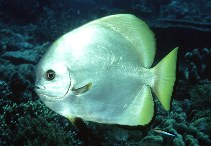| Family: |
Ephippidae (Spadefishes, batfishes and scats) |
| Max. size: |
40 cm TL (male/unsexed) |
| Environment: |
reef-associated; marine; depth range 1 - 50 m |
| Distribution: |
Indo-West Pacific: Indonesia (including Mentawai Islands), New Guinea, and Philippines. |
| Diagnosis: |
Dorsal spines (total): 5-5; Dorsal soft rays (total): 31-34; Anal spines: 3-3; Anal soft rays: 24-28. Juveniles have extremely elongate vertical fins and closely resemble juvenile P. teira, but tend to be lighter with a silvery hue. Adults have smoothly rounded head profile like P. orbicularis, but usually have golden hue and lack small black spots (Ref. 37816). Adults (above 18 cm) yellowish silvery, usually with small, scattered black spots on body, dark bar through eye, and another bar just behind head. Median fins yellowish green. Anal-fin margin and rear margin of caudal fin black. Pelvic fins black. Small juveniles yellowish brown or silvery, with 2 black bars as in adults. Rear third of body blackish, the black colour continued onto dorsal and anal fins, and the front of the black zone on body often closely precede by a narrow faint dark bar. Caudal fin transparent except for black base. Jaws with bands of slender, flattened, tricuspid teeth, the middle cusp barely longer than lateral cups (Ref 43039). |
| Biology: |
Adults occur mostly in large schools along drop-offs, including outer reefs; singly in coastal waters. Juveniles are on deep slopes among tall coral formation (Ref. 48637). Benthopelagic (Ref. 58302). |
| IUCN Red List Status: |
Not Evaluated (N.E.) Ref. (130435)
|
| Threat to humans: |
harmless |
Source and more info: www.fishbase.org. For personal, classroom, and other internal use only. Not for publication.
